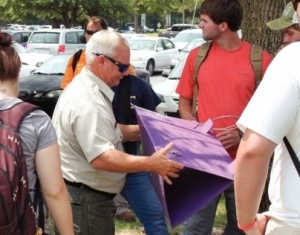A beetle course
By Brandon Davis
Published in News on July 13, 2016 1:46 PM

News-Argus/BRANDON DAVIS
Forest health technician Wayne Langston of the North Carolina Forest Service explains the use of the purple trap for the emerald ash borer beetle.
Fifteen students in Wayne Community College's Insects and Disease class studied an emerald ash borer beetle trap as it hung in a green ash tree at the college Monday.
Students listened to Forest health technicians Wayne Langston and Sara Thompson of the North Carolina Forest Service explain the dangers ash trees in Wayne County face when eaten by the beetle. Students then pulled the purple triangle-shaped prism trap up in the tree.
No beetles appeared on the trap due to the Emerald Ash Borer feeding season ending in June according to Langston, but Ryan Underwood enjoyed seeing a tree protected.
"I'm involved in the outdoors a lot," Underwood said, who is obtaining a Forest Management Technology Degree. "I enjoy a healthy forest, keep a healthy forest vigorous."
Underwood said the beetle attacks all species of ash trees and eats the nutrients found in the cambium layer of the tree, which eventually destroys the tree.
His instructor, Jim Moeller, contacted the N.C. Forest Service three weeks ago after his class looked at an ash tree in front of the college to study the positives and negatives of mowing around an ash tree. The class then became curious if an Emerald Ash Borer lived in the tree.
Moeller brought up questions about the beetle and the trap for Langston and Ms. Thompson to answer before his students entered the Magnolia Building to learn more about ash trees.
Langston said the color of the trap attracts the beetle, and the Tanglefoot glue on the trap kills the beetle. The beetle threatens the manufacturing of baseball bats and tool handles made from the ash tree according to Langston.
He and Ms. Thompson and other Forest Health Technicians check traps every six weeks and mark the location of the beetles on a map. Ms.Thompson said the beetle could wipe out every ash tree in Wayne County and in America if not treated.
But the beetle's travel time across the country is extremely slow.
"The amazing thing about this insect is it travels 5 to 15 miles a year, and it was found in 2002 in Detroit," Moeller said. "So, 14 years later it's (traveled) hundreds of miles at least (to) here."
The exact amount of Emerald Ash Borer in the state and in Wayne County is uncertain, but Langston and Ms. Thompson described the amount of beetles as "acres" of them.
They said there have been no threats at people's homes in Wayne County, but said people should burn locally and not move firewood, which would transport insects to other trees.
"We don't have ash here like they do up north just like solid strands of it,"
Ms. Thompson said. "All of our rivers have ash lining them, so if all those trees die, it's going to change landscapes."
